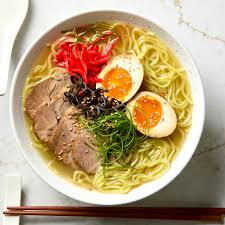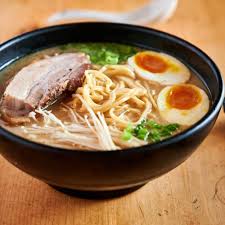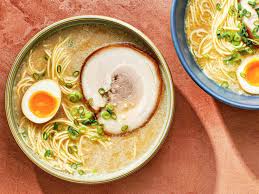Introduction
Tonkotsu Ramen is one of Japan’s most beloved dishes — a rich, flavorful noodle soup known for its creamy pork bone broth, springy noodles, and irresistible toppings. Originating from Fukuoka, Japan, this ramen variety has become world-famous for its deep umami flavor and satisfying warmth.
While often viewed as indulgent comfort food, Tonkotsu Ramen can actually offer several health benefits when made with fresh ingredients and enjoyed in moderation. From its nutrient-rich broth to its protein-packed toppings, Tonkotsu Ramen is more than just a delicious meal — it’s a cultural experience that nourishes both body and soul.
The Origin of Tonkotsu Ramen
Tonkotsu Ramen was first created in Hakata, Fukuoka, on Japan’s southern island of Kyushu. “Tonkotsu” literally means “pork bones” in Japanese. The dish was born in the 1940s as a fast, hearty meal for workers and travelers.
The signature element — a milky, creamy broth — is made by boiling pork bones for 12 to 18 hours, breaking down collagen, marrow, and fat into a rich, flavorful soup. Over time, this dish spread across Japan and the world, becoming a cornerstone of Japanese cuisine.
Today, Tonkotsu Ramen is served in restaurants everywhere, from small ramen shops in Tokyo to global ramen chains like Ichiran and Ippudo.
The Key Ingredients in Tonkotsu Ramen
1. Tonkotsu Broth
The heart of this dish is its pork bone broth, simmered for hours until it becomes thick and creamy.
-
Health Benefits: Rich in collagen, amino acids, calcium, and minerals that support joint, skin, and bone health. Collagen helps maintain youthful skin and supports muscle recovery.
2. Ramen Noodles
Tonkotsu Ramen typically uses thin, firm wheat noodles that perfectly absorb the broth’s flavor.
-
Health Benefits: Provides complex carbohydrates for steady energy. Whole-grain or low-sodium versions can make it even healthier.
3. Chashu (Braised Pork Belly)
Tender slices of chashu pork add rich flavor and protein.
-
Health Benefits: A source of high-quality protein, essential for muscle growth and repair.
4. Toppings
Common toppings include:
-
Soft-boiled eggs (Ajitsuke Tamago) – rich in protein, choline, and healthy fats.
-
Green onions – add freshness and antioxidants.
-
Nori (seaweed) – provides iodine, vitamins, and minerals.
-
Bean sprouts or bamboo shoots – offer fiber and aid digestion.
5. Seasonings
Ingredients like soy sauce, garlic, sesame oil, and ginger enhance the flavor and bring their own health-promoting properties. Garlic and ginger, for example, help boost immunity and improve circulation.
Types of Tonkotsu Ramen
1. Hakata Ramen
The original and most famous version from Fukuoka. Thin noodles, strong pork flavor, and minimal toppings.
2. Kurume Ramen
An older variation with a more concentrated broth, made by reusing portions of older broth to enhance depth.
3. Tokyo Tonkotsu
A lighter, soy-flavored version popular in the capital, often combining chicken and pork broths.
4. Modern Fusion Tonkotsu
Contemporary versions mix new flavors like miso, spicy chili oil, or plant-based ingredients for vegan ramen lovers.
Health Benefits of Tonkotsu Ramen
1. Rich in Collagen and Nutrients
The long-simmered pork bone broth contains gelatin, collagen, calcium, and amino acids, which:
-
Strengthen bones and joints
-
Support skin elasticity and hydration
-
Improve gut health and digestion
2. Provides Protein and Energy
From the pork slices, eggs, and noodles, Tonkotsu Ramen is a well-balanced meal that provides both protein and carbohydrates — perfect for restoring energy after a long day.
3. Supports Immune Health
The combination of garlic, ginger, green onions, and seaweed provides natural antioxidants and minerals that help strengthen the immune system and fight inflammation.
4. Comfort and Mental Wellness
Warm, flavorful ramen offers psychological comfort and stress relief. The savory umami flavor helps stimulate pleasure responses in the brain, making it a feel-good food for emotional balance.
5. Hydration and Electrolytes
Broth-based dishes help maintain hydration, while ingredients like miso or soy add electrolytes and minerals that keep your body balanced.
How to Make Healthier Tonkotsu Ramen at Home
Here’s a simplified and health-conscious version of Tonkotsu Ramen you can enjoy guilt-free.
Ingredients:
-
2 pounds pork bones
-
8 cups water
-
1 tablespoon sesame oil
-
1 tablespoon soy sauce (low-sodium)
-
2 cloves garlic, minced
-
1-inch piece of ginger, sliced
-
2 servings thin ramen noodles
-
2 soft-boiled eggs
-
Sliced green onions, nori, and bean sprouts for topping
Instructions:
-
Prepare the broth: Boil pork bones for 10–12 hours, skimming impurities. Add garlic, ginger, and soy sauce in the last hour.
-
Cook the noodles: Boil ramen noodles until firm, then drain.
-
Assemble the bowl: Pour hot broth into a bowl, add noodles, and top with eggs, vegetables, and chashu pork.
-
Garnish: Add sesame oil or chili oil for extra flavor.
💡 Tip: Use less salt and more vegetables to make your ramen heart-healthy and lower in fat.
Tonkotsu Ramen in Japanese Culture
In Japan, ramen is more than just a meal — it’s a culinary ritual and cultural symbol. Each bowl reflects craftsmanship, patience, and the dedication of ramen chefs who often spend years perfecting their recipes.
Ramen shops in Japan, especially in Fukuoka, are community hubs where locals gather to share a comforting meal. The slurping sound while eating is even seen as a compliment to the chef, showing appreciation for the food’s flavor and texture.
Globally, Tonkotsu Ramen represents the art of slow cooking and balance, combining nutrition, flavor, and tradition in every bowl.
Conclusion
Tonkotsu Ramen is not just a Japanese comfort food — it’s a bowl full of tradition, nourishment, and satisfaction. Its collagen-rich broth, protein-packed toppings, and flavorful seasonings make it a meal that delights the senses while providing real health benefits.
When made thoughtfully with fresh ingredients and balanced portions, Tonkotsu Ramen can be a nutrient-dense, soul-warming dish that supports wellness, energy, and happiness.
Whether you enjoy it in a Tokyo ramen shop or cook it at home, every spoonful of Tonkotsu Ramen tells the story of Japan’s culinary artistry and love for good food.




You must be logged in to post a comment.